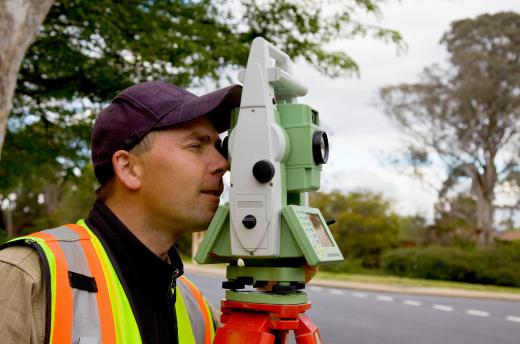What Is a Theodolite?
A theodolite is a device for measuring horizontal and vertical angles. The traditional theodolite consists of a sighting instrument that can be rotated horizontally and vertically, and two calibrated circular plates, positioned so as to measure the amount of horizontal or vertical rotation in degrees. By pointing the sighting instrument, which can be a telescope, at an object, it is possible to measure its horizontal and vertical angles relative to suitable reference points. Normally, these would be true north for horizontal angles and the horizon for vertical angles. Theodolites have been used in navigation and astronomy and are today most commonly employed in surveying — either for building and construction or in geographical surveys.
When used for geographical surveying, a theodolite can help determine the distance and height of a feature, for example a hill or mountain. By measuring the horizontal angle, relative to true north, of the feature from two different locations a known distance apart, the distance can be calculated by trigonometry. Once the distance is known, the height can be determined in the same way by measuring the vertical angle of the feature relative to the horizon.

It is difficult to precisely identify the date on which the first theodolite was constructed, as throughout history a variety of devices bearing varying degrees of resemblance to a modern theodolite have been introduced. The earliest record of a device of this type dates from around 150 BCE in ancient Greece; it was called a dioptra and had two metal plates which could be rotated horizontally and vertically, along with a method of leveling involving tubes containing water. It was used for astronomical observations. The term “theodolite” first appeared in 1571 when the English mathematician Leonard Digges described an instrument for measuring angles called a “theoloditus;” however, it appears that it measured horizontal angles only. In 1653, William Leybourn, an English surveyor and author, provided a detailed description of a theodolite which could measure angles both horizontally and vertically and incorporated a compass as well as a sight.
Modern theodolites work on the same principles as their predecessors, but with improvements in precision and portability. They have telescopic sights and can measure angles with an accuracy of up to one tenth of an arc second. An electronic theodolite often incorporates an infrared device to measure distances and may have a processor and software to carry out calculations and store results internally or download them to a laptop or PC. This type of system is sometimes called a “total station.”
AS FEATURED ON:
AS FEATURED ON:











Discuss this Article
Post your comments